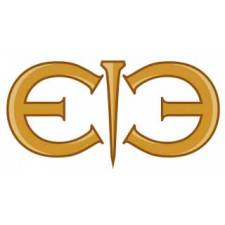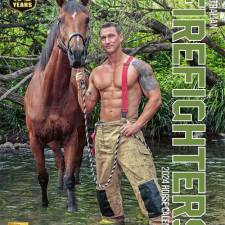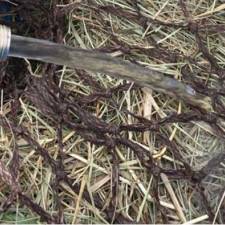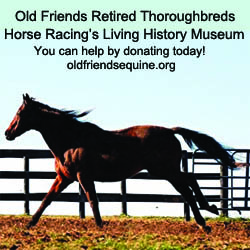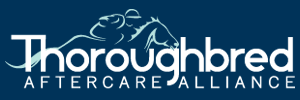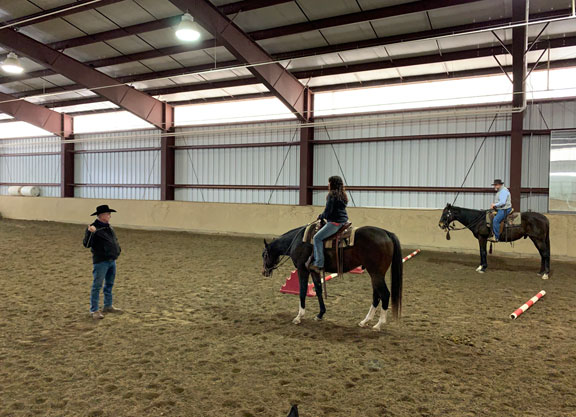
by Doug Jordan
It seems there is no end to the number of scenarios where off-track Thoroughbreds can adapt and expand the scope of their abilities in second careers. With the number of horses coming off the track that need transitioning, and the ever-increasing pressure on the racing industry to be effective in placement, it’s important that the industry explore every avenue of effective transitioning and education of future owners/riders.
Earlier this month, National Cutting Horse Hall of Fame trainer Doug Jordan put on a clinic at Long Shadows Farm in Cambridge, NY in training horses and riders on the basics of ‘cutting’ using a flag. Cutting is an activity in which a horse and rider work together to maneuver a cow to a separate pen or place. Cutting competitions demonstrate the horse’s athleticism and mental agility.
The flag is actually the face of a fan attached to a line along a wall or fence, and a pulley system that is operated by Jordan during the training to simulate the movements of a cow. The goal in having the clinic at Long Shadows was to include Thoroughbreds to show how well they took to the activity and what a great tool it could become for improving the rate of success in transition from racing to any second career.
Working a horse on a flag trains the rider to allow a better connection with his or her horse, and gives the horse more responsibility and freedom in the relationship.
“The flag is an excellent way to present something to the horse to develop that lighter level of communication that comes with connection between horse and rider,” said Jordan. “I trained cutting horses my whole life and we use the flag to teach the horse to rate and measure something moving.
The horse is interested in it and wants to engage in the activity. Because the horse is a willing participant, it’s just a nice way to get the horse to operate with less pressure and operate from a light feel. The change happens quickly.”
Among the riders at the Long Shadows clinic was Tim Jones of Godolphin. Tim is based in Saratoga Springs at Godolphin’s Greentree training center and rode Malibu Master (Malibu Moon), owned by ACTT Naturally, Inc., one of the three participating off-track Thoroughbreds.
Malibu Master was joined by Fuhrious Warrior (Langfuhr), also of ACTT Naturally, ridden by Valerie Buck. I rode Maestro’s Legacy (Pavarotti), a horse I helped transition at my farm in New York.
“At Godolphin, we are committed to finding homes for our horses,” said Jones. “Through Godolphin Lifetime Care, we give away a number of horses each year to approved people who want to advance the horse in another discipline. Anything that we can do as an industry to better the communication between horse and rider, is critical.
In that, we need more knowledge and understanding of the horses and how they think and operate. Having someone like Doug who has such a deep understanding of the horse and a method of putting people and their horses in a better frame of mind to grow together is an important tool for our industry.”
“I am interested in helping horses,” said Jordan. “Looking at the life of a race horse and the change they need to make motivates me to help people learn, with just a little observation and understanding from the human, what a horse is capable of. The Thoroughbred is very intelligent and sensitive and for them, that connection and relationship with their rider is very important for their success.”
“Allowing the horse time to think and participate in what it is doing, makes a difference,” said Jones. “For our breed, their life on the racetrack is short and we need more ways to make better and more transitions to another life. I see Doug and his work as a way for us to accomplish this.”
Jordan became hooked on horses and cutting at the age of 11. He had successfully trained his first competitive cutter by the time he was just 13. He has numerous titles from major National Cutting Horse Association (NCHA) events and was inducted into the National Cutting Horse Association’s Hall of Fame in 2000, after being only the second rider ever to win every go-round in the history of the NCHA Futurity.
Early on, Jordan avoided traditional methods of horse training that employ repression and punishment. He was a student of Ray Hunt and Tom Dorrance who are seen as the modern ambassadors of natural horsemanship and his style reflects those prominent influences. Jordan frequently collaborates with other experts and is often the teacher of the teachers in training for cutting or in just solving basic day to day difficulties that people may have with their horses.
Jordan’s goal is the help all riders and horses with whom he comes in contact to develop a connection and a better relationship. In that way, everything that people and their horses do together, from walking down a lane to competing in a three-day-event will be better, safer and more enjoyable for the horse and rider.
By focusing on key components like proper timing, positioning, developing feel, building confidence and of course, understanding how a horse’s mind operates, more people can enjoy the companionship of an off-track Thoroughbred.
“In helping people with Thoroughbreds, you want to really work on the communication between the horse and rider,” said Jordan. “Thoroughbreds are smart and sensitive. The biggest problem that you tend to see with people retraining Thoroughbreds is connection and riders using too much pressure, too fast.
By training on the flag, you get to slow things down and allowing the horses to be a part of the process and make decisions, the horse gets into a better frame of mind and the rider gets the confidence and opportunity to offer lightness. This gives the horse a feeling that it goes back to time and time again in every other activity you attempt.”
“In following the flag today, I could really feel my horse’s mind engage in the activity and his body followed,” said Valerie Buck of her horse Fuhrious Warrior. “He can be spooky and unpredictable. His confidence increased as I let him take control of the activity.
He started out wary and ended up focused and forward. I can see that helping us in other situations where he questions his confidence.”
“Malibu and I started out working about 30 feet from the flag,” said Jones. “That was his bubble. By the end of our second session, my horse was relaxed and 3-4 feet away. He started out nervous but by giving him confidence and encouraging him to explore the activity, he really got into it and we became a team. I could really feel the change.”
“That is why I’m here,” said Jordan. “I want people to feel the communication that they can have with the horse. It makes people feel good and makes the horse feels good.”
Contact Doug Jordan at jordanoaksranch.com. Learn more about Godolphin Lifetime Care.
Diana Pikulski is the editor of the Thoroughbred Adoption Network and a partner at Yepsen & Pikulski.
This article originally appeared on Thoroughbred Daily News and is published here with permission.
Find more relevant articles in our section on Retire & Rehome.







